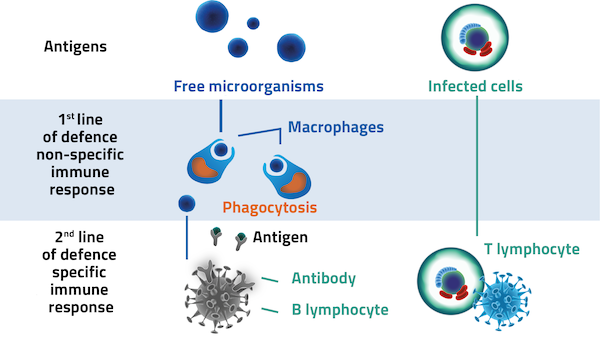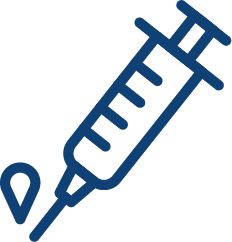
The immune system
Immunity is the natural mechanism designed to fight external aggressions to the human body. These so-called aggressors are foreign cells or bodies, recognised as “non-self” by the body, which enter the body through the skin or mucous membranes. This includes, for example, bacteria, viruses, fungi, parasites, allergens, toxic pollutants, etc.
Immunity is provided by the immune system, a highly complex defence system comparable to a legion of tiny soldiers ready to fight when a threat arises.
This system is organised into two lines of defence:

Innate immunity
Innate immunity: the fastest, it constantly monitors and prevents infectious agents (aggressors), whatever they may be, from penetrating and multiplying in the body. It calls on several types of “soldiers” (white blood cells, cytokines, interferons, etc.) and protective stratagems (tears, mucus, fever, etc.)
Adaptive immunity


- The production of specific antibodies, which will recognise and attempt to destroy the intruder they are acting against. This is called humoral immunity. Antibodies bind to the antigen, just like a key fits a lock. This complex combination is sometimes enough to render the antigen harmless, to neutralise or eliminate it.
- Cellular immunity mainly targets viruses that penetrate the cells. When necessary, cells belonging to the innate immunity system will present antigens to Th or B lymphocytes (memory) in order to activate them. Some of these lymphocytes will help the humoral response function. Others will secrete cytokines (like messengers) and cause an

The ability of memory cells also explains why we only get some diseases once, against which we remain “immune”, once. It is this mechanism that is targeted by vaccination: by administering a low dose of an antigen, we stimulate the system to remember its profile and produce specific antibodies.
The particular case of COVID-19
1. Ana B. Pavel et al., Th2/Th1 Cytokine Imbalance Is Associated With Higher COVID-19 Risk Mortality, Front. Genet., 16 July 2021 | https:/doi.org/10.3389/fgene.2021.706902
2. V. Bonny et al., COVID-19 : physiopathologie d’une maladie à plusieurs visages – La Revue de médecine interne 41 (2020) 375–389
Source : https:/www.mongeneraliste.be/nos-dossiers-section/les-infections-virales-bacteriennes/
